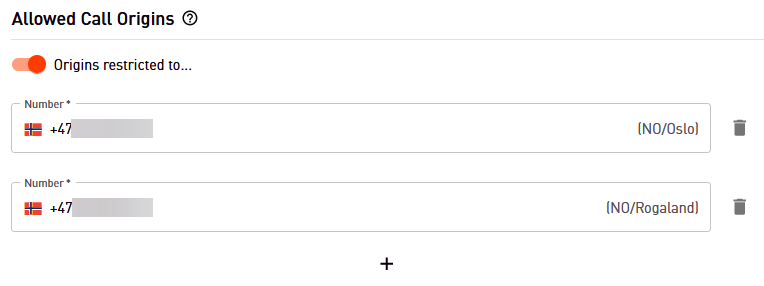CVG 1.13.8 (06-Aug-2021)
This August update
enables our security-sensitive customers to only allow certain systems to forward calls to bots,
makes the languages spoken in 🇧🇪 Belgium, 🇨🇦 Canada, 🇱🇻 Latvia and 🇱🇹 Lithuania available for our friends, partners and customers,
eventually enables that SSML can be used now also for Microsoft TTS voices!
Restricted Call Origins
In some use cases, calls should only be able to be routed to CVG from specific systems, usually contact centers. It should not be possible to call the bots directly.
An example of this is where the caller is first authenticated by a human agent before being allowed to use a voicebot to enroll in a specific service.
To enable use cases like this we have introduced a new section “Allowed Call Origins” in the advanced options of the bot settings. The phone numbers entered here are compared to the user part in the P-Asserted-Identity SIP header. If they don’t match, the call is rejected.

New supported Languages and Voices
For Latvian (lt-LT) and Lithuanian (lv-LV) the newest neural TTS voices from Microsoft are now available, a male and a female voice each.
To enable voicbots in Belgium and Canada the following Languages are supported additionally:
Dutch, Belgium (nl-BE)
French, Belgium (fr-BE)
French, Canada (fr-CA)
For all these languages we also support the newest neural voices from Microsoft.
SSML Support for Microsoft TTS Voices
Many of our customers have been waiting to be able to use the Speech Synthesis Markup Language (SSML) for Microsoft TTS voices as well. SSML allows voice dialog developers to fine-tune the pitch, pronunciation, speaking rate, volume, and more of the text-to-speech output.
CVG has been enabling the use of SSML for TTS from Amazon, Google, IBM and Nuance for quite some time. Now we’ve added SSML support for Microsoft’s TTS voices too!
The so-called “SSML documents” are a bit more bulky than with the other vendors:
You must specify the URI to the document that defines the markup vocabulary (the element types and attribute names) of the SSML document.
You must specify the name of the voice in each SSML document.
Here is an example of pausing and changing the speaking rate:
<speak version="1.0" xmlns="http://www.w3.org/2001/10/synthesis" xml:lang="en-US">
<voice name="en-US-AriaNeural">
For your phone number, I have detected a voice registration.
Please say: <break strength="medium" />
<prosody rate="-20.00%">
At Vier my voice is my secure password.
</prosody>
</voice>
</speak>
Microsoft specific SSML elements are not supported
Optional SSML elements unique to Microsoft Text-to-Speech starting with mstts:, e.g. the mstts:express-as element (which only works for a few specific Microsoft TTS voices), are not supported.